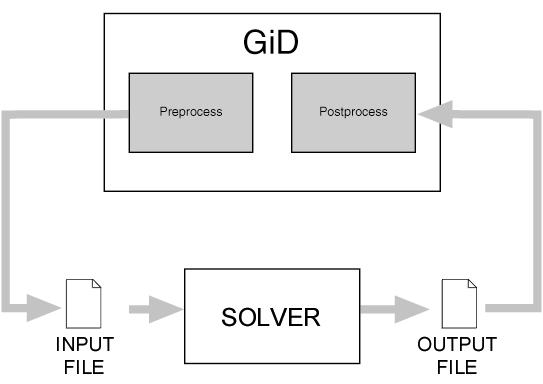GiD - The personal pre and post processor
Interaction of GiD with the calculating module
GiD Preprocess makes a discretization of the object under study and generates a mesh of elements, each one of which is assigned a material and some conditions. This preprocessing information in GiD (mesh, materials, and conditions) enables the calculating module to generate results. For the present example, the calculating module will find the distance of each element relative to the center of mass of the object.
Finally, the results generated by the calculating module will be read and visualized in GiD Post-process.
GiD must adapt these data to deal with them. Materials, boundary and/or load conditions, and general problem data must be defined.
GiD configuration is accomplished through text formatted files.
From the 13th version of GiD, a new problemtype system has been developed (based on the customlib library). It offers more powerful integration tools, and a more efficient and user-friendly way to interact with the data. It uses a single .spd file to describe general properties, materials, conditions and units (as a tree with xml syntax). All this data is shown in a 'tree view', and materials and conditions are associated to groups of entities.
The 'classic' problemtypes system is currently also supported by GiD, but it is considered deprecated, as the new system offers many advantages. Information about how to create a problemtype using the 'classic style' can be found in the Annex of this manual.
The calculating module (in this example cmas2d.exe) solves the equations in the problem and saves the results in the results file. This module may be programmed in the language of your choice, 'C' in used in this example.
GiD Post-process reads the following files generated by the calculating module:
project_name.post.res: results file.
Each element of the mesh corresponds to a value.
project_name.post.msh: file containing the post-process mesh. If this file does not exist, GiD uses the preprocess mesh also for postprocess.
COPYRIGHT © 2022 · GID · CIMNE
